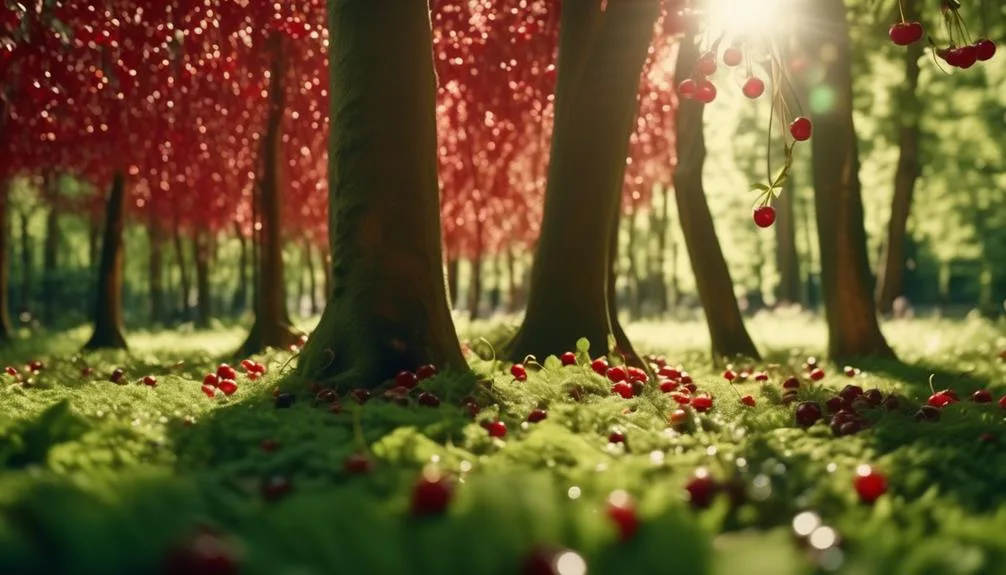Can Cherry Trees Thrive in Shaded Areas?
You might believe cherry trees need full sun, but some varieties can handle shade. If you've hesitated to plant them in your shady yard, there's more to consider. Understanding the conditions cherry trees need can help you decide if they can grow in shaded areas.
Stick around to find out what influences cherry tree growth and how to choose the right variety for your environment.
Cherry Trees and Sunlight Requirements
To thrive and produce an abundant harvest, cherry trees require ample sunlight throughout the day. Sunlight is essential for the process of photosynthesis, which is crucial for the tree's growth and fruit production. Cherry trees typically need at least 6-8 hours of direct sunlight to thrive and bear fruit.
Insufficient sunlight can lead to poor fruiting and overall weaker tree health. However, cherry trees do have some level of shade tolerance, especially during the hottest parts of the day. They can tolerate light shade, but it's important to ensure they still receive the necessary amount of sunlight.
If you're considering planting cherry trees in a shadier area, it's important to assess the specific light conditions to determine if it will provide adequate sunlight for the trees to grow and produce fruit.
Understanding Cherry Tree Growth Conditions
For optimal cherry tree growth, ensuring they receive ample sunlight is essential, as it directly impacts their ability to thrive and produce fruit. The tree canopy plays a crucial role in this.
Cherry trees thrive in full sunlight, so it's important to ensure they're not shaded by other trees or structures.
Additionally, soil acidity is a key factor. Cherry trees prefer slightly acidic soil with a pH level between 6.0 and 6.8. Test your soil to determine its acidity and make necessary amendments to ensure it's within the ideal range for cherry tree growth.
Understanding these growth conditions is vital for successfully cultivating cherry trees. By providing adequate sunlight and ensuring the soil acidity is suitable, you can create an environment where cherry trees can flourish and produce abundant, delicious fruit.
Factors Affecting Cherry Tree Growth
Understanding the various factors that influence cherry tree growth is crucial for cultivating healthy and productive trees in your garden. Several key factors can significantly impact the growth and overall health of cherry trees:
- Soil composition: The type of soil and its nutrient content play a vital role in cherry tree growth. Ensure the soil is well-draining and rich in organic matter to support healthy root development.
- Watering frequency: Adequate and consistent watering is essential for cherry tree growth, especially during the growing season. Be mindful not to overwater or underwater, as both can negatively affect the tree's health.
- Sunlight exposure: Cherry trees thrive in full sunlight, so ensure they receive at least 6-8 hours of direct sunlight daily.
- Pruning and maintenance: Regular pruning and maintenance help promote proper air circulation and sunlight penetration, crucial for tree growth.
- Pest and disease control: Monitoring for pests and diseases and taking prompt action is essential for maintaining tree health and promoting growth.
Understanding and actively managing these factors will contribute to the successful growth of your cherry trees.
Choosing the Right Cherry Tree Variety
Selecting the right cherry tree variety is essential for ensuring successful growth and a bountiful harvest in your garden. When it comes to shade tolerance, consider varieties such as the Black Tartarian or Stella, which are known for their ability to thrive in shadier conditions. These shade-tolerant cherry varieties are ideal for gardens with limited direct sunlight.
Additionally, it's crucial to consider the soil acidity for cherries. Most cherry trees prefer slightly acidic soil with a pH range of 6.0 to 6.8. However, if you have alkaline soil, you can opt for varieties like the Montmorency, which is more adaptable to higher pH levels.
Tips for Growing Cherry Trees in Shady Areas
Now that you've found the right cherry tree variety for shady areas, let's explore some essential tips for successfully growing them in such conditions. Here are some key tips to help you nurture cherry trees in shady areas:
- Pruning Techniques: Regularly prune your cherry trees to remove dead or crowded branches, allowing more light and air to reach the tree.
- Soil Composition: Ensure the soil is well-draining and rich in organic matter to support healthy root growth in shady conditions.
- Watering Schedule: In shady areas, adjust the watering schedule to prevent waterlogging, ensuring the soil is consistently moist but not waterlogged.
- Fertilizer Application: Apply a balanced fertilizer in early spring to provide essential nutrients for healthy growth in shaded environments.
- Monitor Light Levels: Keep an eye on the light exposure and consider strategic pruning to optimize light penetration to the tree.
Following these tips will help you cultivate thriving cherry trees in shady areas.
Conclusion
Ultimately, with proper care and attention, cherry trees can thrive in partial shade. Understanding their sunlight needs, selecting the right variety, and providing extra care will support their healthy growth even in shady areas.
Consider the implications of this adaptable nature and the potential for successful cherry tree cultivation in various environments.
Happy gardening!

My interest in trees started when I first saw the giant sequoias in Yosemite.
I was a teenager then, and I remember thinking, “I need to learn more about this.”
That moment stuck with me.
A few years later, I went on to study forestry at Michigan Tech.
Since graduating, I’ve worked in a mix of hands-on tree care and community education.
I’ve spent over ten years helping people understand how to plant, maintain, and protect the trees in their neighborhoods.
I don’t see trees as just part of the landscape.
They are living things that make a real difference in our daily lives.
